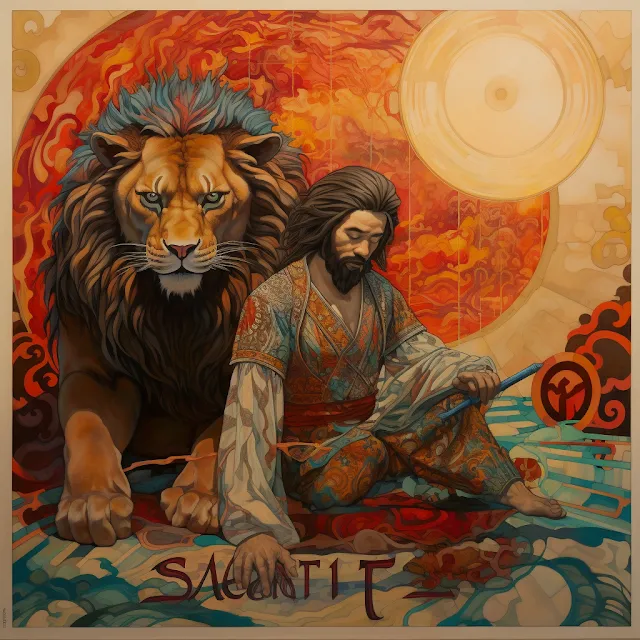"Art of War" can appear deeply Taoist
The "Art of War" by Sun Tzu is an ancient Chinese military treatise that has long been influential for its strategic doctrine, and while it is not a Taoist text in the religious sense, its principles harmonize with Taoist philosophy. The text’s author, Sun Tzu, lived during the era of the Warring States, a time when Taoism and Confucianism emerged and flourished in China
Taoism emphasizes aligning oneself with the natural flow of the world, or the "Dao," and stresses the idea of effortlessness in action, known as "wu wei," which translates to "non-action" or "effortless action." Although "wu wei" does not appear explicitly in "Art of War," readers familiar with Taoist ideas would recognize the strategic advantage of minimal disturbance in Sun Tzu’s advice for leaders to take the path of least resistance in military campaigns. In Taoist metaphysics, what is considered the most natural course of action often leads to the best outcomes, and this resonates with Sun Tzu’s military strategies which often advocate winning by outsmarting the enemy and achieving victory with minimal conflict
For instance, Sun Tzu’s concept of "shì," which can refer to situational potential or the alignment of forces in a way that they are poised to take advantage of the situation, is an example of such harmonization with Taoist thinking. The idea is to understand and utilize the inherent potential within a situation—much like a Taoist would observe and harness the natural flow or "Dao" of the environment
Additionally, leaders in the People's Republic of China historically used strategies similar to those found in "Art of War" and influenced by Taoist concepts, as demonstrated by Beijing's methodical and patient approach to international affairs, such as integrating itself into organizations like the United Nations by nurturing relationships over time and making small strategic moves—again reflecting the Taoist principle of "wu wei"
In summary, while the "Art of War" is not a Taoist text, its content and the methodology prescribed by Sun Tzu show clear parallels with Taoist beliefs and practices. Understanding "Art of War" through the lens of Taoist philosophy can provide deeper insight into China’s strategic tradition and universal lessons that extend beyond mere military tactics
The relationship between Sun Tzu's "Art of War" and Taoism is intellectually intriguing because it demonstrates how seemingly practical military strategies can embody philosophical principles that aim to harmonize with the natural order. The appearance of Taoism in Sun Tzu's work can be seen in several key areas:
Strategic Alignment with the Natural Order: Sun Tzu focuses on adapting to and utilizing the environment and circumstances to achieve military success. This is analogous to the Taoist principle of aligning with the Tao, the ultimate source and principle of the universe in Taoism, where the course of action is adapted to the natural flows of the world.
Efficient Use of Energy: One of the central themes in "Art of War" is the efficient use of resources and energy, typified by the avoidance of direct conflict when it is not necessary. This mirrors the Taoist concept of "wu wei," which implies an understanding of when effort is required and when an action can be accomplished through minimal effort by aligning with the natural course of events.
Flexibility and Non-Contention: Sun Tzu emphasizes the importance of being flexible and able to respond to changing situations. This non-contentious approach resonates with Taoist philosophy's appreciation for flexibility and the ability to remain detached and not assert force unnecessarily.
Victory Without Battle: One of the most famous tenets of Sun Tzu's "Art of War" is the achievement of victory without fighting. This principle aligns with the Taoist aim to accomplish tasks without confrontations and to win by cunning, much in the way water flows around obstacles rather than through them.
Preparation and Timing: Sun Tzu teaches that success is born of careful preparation and taking action only at the most opportune moments. Similarly, Taoism suggests acting only in accordance with the natural rhythm of the environment, doing the right thing at the right time.
Balance and Harmony: Both "Art of War" and Taoism emphasize the need for balance and harmony. In military applications, this means balancing hardness with softness, comparing it with the Taoist pursuit of balance in all aspects of life.
In essence, the "Art of War" can appear deeply Taoist because it advocates for strategies that work with, rather than against, the fundamental elements and dynamics at play, be they in conflict situations or the wider cosmos. It speaks to an inherent wisdom of utilizing the path of least resistance to achieve one's objectives, something at the very heart of Taoist philosophy.
"หนังสือ 'ศิลปะแห่งการรบ' โดย ซุนวู เป็นตำราทางทหารของจีนโบราณที่มีอิทธิพลต่องานคิดด้านยุทธศาสตร์มาอย่างยาวนาน แม้จะไม่ใช่หนังสือเกี่ยวกับศาสนาเต๋าในแง่ของปรัชญาเชิงศาสนา แต่หลักการในหนังสือก็สอดคล้องกับปรัชญาเต๋า ผู้เขียนอย่างซุนวู มีชีวิตอยู่ในยุคสงครามระหว่างรัฐที่เต๋าและขงจื๊อเริ่มเติบโตและเจริญในประเทศจีน
เต๋ามุ่งเน้นการปรับตัวให้เข้ากับกระแสธรรมชาติของโลก หรือ 'เต๋า' และเน้นแนวคิดเรื่องการกระทำที่ไม่ต้องพยายามมากเกินไป ที่เรียกว่า 'วูเว่ย' ซึ่งแปลว่า 'ไม่-การกระทำ' หรือ 'การกระทำที่ไม่ต้องใช้ความพยายามมาก' ถึงแม้ว่าคำว่า 'วูเว่ย' อาจจะไม่ปรากฏชัดเจนใน 'ศิลปะแห่งการรบ' แต่ผู้ที่คุ้นเคยกับความคิดเต๋าจะเห็นถึงข้อได้เปรียบทางยุทธวิธีจากคำแนะนำของซุนวูที่ให้ผู้นำเลือกเส้นทางที่ต่อต้านน้อยที่สุดในการรบ ในปรัชญาเต๋าวิญญาณ สิ่งที่เป็นโต้ตอบตามธรรมชาติมักจะนำไปสู่ผลลัพธ์ที่ดีที่สุด และนี่ก็ตรงกับยุทธวิธีทางทหารของซุนวู ซึ่งมักจะสนับสนุนให้ชนะโดยใช้ความฉลาด และได้ชัยชนะด้วยการมีความขัดแย้งน้อยที่สุด
ตัวอย่างเช่น แนวคิด 'ซื่อ' ของซุนวู ซึ่งสามารถหมายถึงศักยภาพของสถานการณ์หรือการจัดตั้งกำลังในทางที่พวกเขามีโอกาสใช้ประโยชน์จากสถานการณ์ได้ นี่เป็นตัวอย่างของการสอดคล้องกับการคิดเต๋า แนวคิดคือการเข้าใจและใช้ศักยภาพที่ซ่อนอยู่ในสถานการณ์ - เช่นเดียวกับว่าเต๋าจะสังเกตและใช้ประโยชน์จากกระแสธรรมชาติ หรือ 'เต๋า' ของสิ่งแวดล้อม
นอกจากนี้ ผู้นำในสาธารณรัฐประชาชนจีนตลอดประวัติศาสตร์ได้ใช้กลยุทธ์ที่คล้ายคลึงกับ 'ศิลปะแห่งการรบ' และได้รับอิทธิพลจากแนวคิดเต๋า เช่นการใช้วิธีการที่มีระบบและมีความอดทนในเรื่องการต่างประเทศ อย่างการผนวกตัวเองเข้ากับองค์กรเช่นสหประชาชาติโดยการสร้างความสัมพันธ์เป็นเวลานานและทำการย้ายขั้นตอนเล็กๆ อีกครั้งสะท้อนแนวคิดเต๋าของ 'วูเว่ย'
โดยสรุป, แม้ว่า 'ศิลปะแห่งการรบ' ไม่ใช่หนังสือเต๋า, แต่เนื้อหาและวิธีการที่ซุนวูแนะนำแสดงให้เห็นถึงความสอดคล้องกับความเชื่อและปฏิบัติของเต๋าได้อย่างชัดเจน การเข้าใจ 'ศิลปะแห่งการรบ' ผ่านมุมมองของปรัชญาเต๋าสามารถให้ข้อมูลเชิงลึกเกี่ยวกับประเพณียุทธวิธีของจีนและบทเรียนทั่วไปที่ไม่เพียงแต่จำกัดอยู่ในยุทธวิธีทางทหารเท่านั้น
ความเกี่ยวข้องระหว่าง 'ศิลปะแห่งการรบ' ของซุนวูกับเต๋านั้นน่าสนใจทางปัญญาเพราะมันแสดงให้เห็นว่ากลยุทธ์ทางทหารที่ดูเหมือนจะเป็นเรื่องปฏิบัติสามารถรวมปรัชญาที่มุ่งทำให้เข้ากับระเบียบธรรมชาติได้อย่างไร การปรากฏตัวของเต๋าในผลงานของซุนวูสามารถเห็นได้ในหลายๆ ด้านหลัก:
การปรับตัวให้ตรงกับระเบียบธรรมชาติ: ซุนวูมุ่งเน้นการปรับตัวให้เข้ากับสภาพแวดล้อมและสถานการณ์เพื่อบรรลุความสำเร็จทางทหาร ซึ่งคล้ายกับหลักการเต๋าที่ปรับให้ตรงกับ 'เต๋า' คือแหล่งและหลักการของจักรวาลในเต๋าว่าการปฏิบัติงานต้องปรับตัวให้เข้ากับกระแสธรรมชาติของโลก การใช้พลังงานอย่างมีประสิทธิภาพ: หนึ่งในหัวข้อสำคัญใน 'ศิลปะแห่งการรบ' คือการใช้ทรัพยากรและพลังงานอย่างมีประสิทธิภาพ โดยการหลีกเลี่ยงการขัดแย้งโดยตรงเมื่อไม่จำเป็น เช่นเดียวกับความคิดเต๋า 'วูเว่ย' ซึ่งหมายถึงความเข้าใจในเวลาที่ความพยายามจำเป็นและเมื่อการกระทำสามารถทำได้ด้วยความพยายามน้อยที่สุดโดยปรับให้เข้ากับกระแสเหตุการณ์ตามธรรมชาติ ความยืดหยุ่นและไม่พยายามทะเลาะวิวาท: ซุนวูเน้นถึงความสำคัญของความยืดหยุ่นและความสามารถในการตอบสนองต่อสถานการณ์ที่เปลี่ยนแปลงไป ทั้งนี้ปรัชญาเต๋ามีการให้ความสำคัญกับความยืดหยุ่นและความสามารถในการรักษาความเป็นกลางและไม่ใช้กำลังโดยไม่จำเป็น การชนะโดยไม่ต้องรบ: หลักของ 'ศิลปะแห่งการรบ' ที่ซุนวูสอนที่เป็นที่รู้จักมากที่สุดคือการบรรลุชัยชนะโดยไม่ต้องต่อสู้ หลักการนี้สอดคล้องกับเป้าหมายเต๋าในการทำงานโดยปราศจากการปะทะและชนะด้วยความฉลาด มากเหมือนกับน้ำไหลผ่านอุปสรรคมากกว่าการพุ่งทะลุ การเตรียมการและเวลา: 'ศิลปะแห่งการรบ' ของซุนวูสอนว่าความสำเร็จเกิดจากการเตรียมการที่รอบคอบและการดำเนินการเพียงในช่วงเวลาที่เหมาะสมเท่านั้น ในทำนองเดียวกัน แนวคิดเต๋าแนะนำให้กระทำเฉพาะในการประสานกับจังหวะทางธรรมชาติของสิ่งแวดล้อม คือทำสิ่งที่ถูกต้องในเวลาที่เหมาะสม ความสมดุลและความสามัคคี: ทั้ง 'ศิลปะแห่งการรบ' และเต๋าเน้นถึงความจำเป็นในความสมดุลและความสามัคคี ในการประยุกต์ใช้ทางทหาร แปลว่าการทำสมดุลระหว่างความแข็งแรงและความนุ่มนวล เปรียบเทียบกับการแสวงหาความสมดุลในทุกด้านของชีวิตตามหลักเต๋า โดยทั่วไป 'ศิลปะแห่งการรบ' อาจจะดูเหมือนเป็นหนังสือเต๋า เพราะมันสนับสนุนแนวทางที่ทำงานร่วมกับแทนที่จะต่อต้านองค์ประกอบพื้นฐานและวิวัฒนาการที่เล่น ไม่ว่าจะในสถานการณ์ความขัดแย้งหรือจักรวาลกว้างใหญ่ นี่หมายถึงความฉลาดที่ซ่อนอยู่ของการใช้เส้นทางที่ต้านทานน้อยที่สุดเพื่อบรรลุเป้าหมาย ซึ่งอยู่ในหัวใจของปรัชญาเต๋า

Comments
Post a Comment